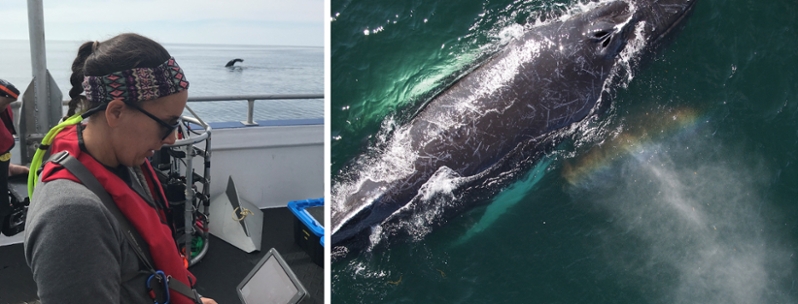UNB PhD student wins 2021 NSERC Science Exposed photo contest
Author: UNB Research
Posted on Nov 22, 2021
Category: Research , Accolades

If you’ve been following our blog for a while, you’ve likely seen Gina Lonati’s photos of whales in the Bay of Fundy.
Last week, the Natural Sciences and Engineering Research Council (NSERC) announced her as one of four winners of their 20201 Science Exposed photo contest. She was awarded one of the three Jury Prizes selected by a group of experts in research and culture.
The annual contest is organized by NSERC and devoted exclusively to images of scientific research, in all fields of study. It is intended to showcase research images and foster interest in science and scientific curiosity, as well as building a database of scientific images in Canada and contributing to new uses for them and the advancement of knowledge generally.
“After learning about the contest from a fellow grad student around this time last year, I decided to enter because it offered a chance to bring more attention to the important research being conducted on whales in Atlantic Canada. I believe science communication is crucial for enacting change for at-risk species, and I find that whales make the job easier by being very photogenic! Ultimately, it’s a privilege to be able to share their beauty through photos, and hopefully to inspire others to better understand and care about the fate of marine wildlife.”
As a doctoral student working with Dr. Kimberley Davies, an assistant professor of biological sciences at UNB in Saint John, Gina is studying the relationship between whale health and body temperature, which she is able to measure when the whales surface.
As part of her field research, Gina flies a quadcopter drone outfitted with multiple cameras, and uses the resulting data to conduct a health assessment of an individual whale.
“Our drone has a visible-spectrum camera that provides a unique, up-close, and non-invasive opportunity to assess a whale’s body condition and look for injuries or entanglements,” she says. “We also have a thermal camera on the drone to collect thermal images to estimate the whale’s body temperature.”
“I photographed this mature male humpback whale in the Bay of Fundy in September 2020. The drone was about 12 metres above the whale, so that we could obtain close-up imagery of the its blowhole when it surfaced for a breath. Whales often exhale a plume of vapor and mucus, called a “blow”, which makes them easy to spot from land or boat. In this photo, the blow happened to reflect the sunlight toward the drone’s camera to create a rainbow!”
While both Gina’s eye and the drone’s cameras were instrumental in creating the image, she’s also quick to share credit with the numerous others who have been a part of her research life.
“I am very thankful to have an extremely supportive team of collaborators who make this research (and the collection of such photos) possible, including my advisor, Dr. Kim Davies, Natasha Hynes (UNB), Dr. Moe Brown (Canadian Whale Institute), Marcia Pearson (Dalhousie University), Danny & Jeremy Barker (F/V Barker Boys), Don LeRoi (Aerial Imaging Solutions) and Jooke Robbins (Center for Coastal Studies).”
Congratulations, Gina!
Header image: Left, a photo of Gina Lonati operating the drone, taken by her supervisor, Dr. Kimberley Davies; right, Gina's award-winning photo.